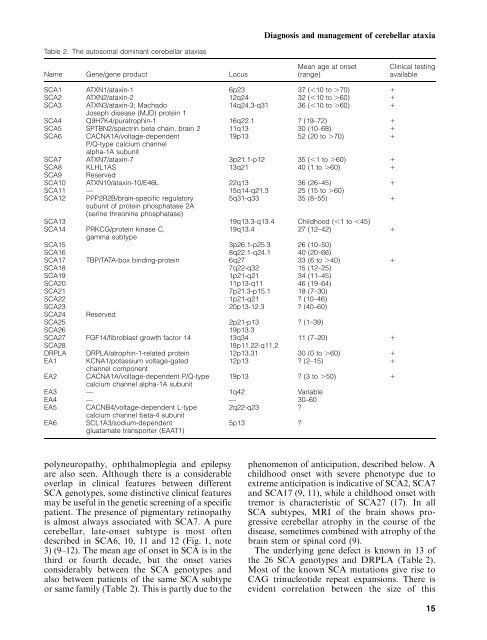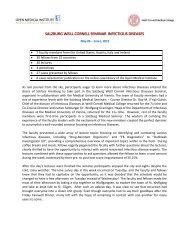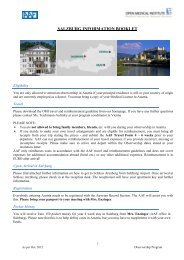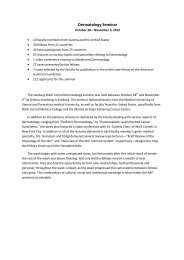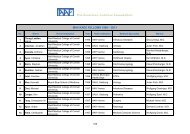Diagnosis and management of early- and late-onset cerebellar ataxia
Diagnosis and management of early- and late-onset cerebellar ataxia
Diagnosis and management of early- and late-onset cerebellar ataxia
Create successful ePaper yourself
Turn your PDF publications into a flip-book with our unique Google optimized e-Paper software.
Table 2. The autosomal dominant <strong>cerebellar</strong> <strong>ataxia</strong>s<br />
Name Gene/gene product Locus<br />
polyneuropathy, ophthalmoplegia <strong>and</strong> epilepsy<br />
are also seen. Although there is a considerable<br />
overlap in clinical features between different<br />
SCA genotypes, some distinctive clinical features<br />
may be useful in the genetic screening <strong>of</strong> a specific<br />
patient. The presence <strong>of</strong> pigmentary retinopathy<br />
is almost always associated with SCA7. A pure<br />
<strong>cerebellar</strong>, <strong>late</strong>-<strong>onset</strong> subtype is most <strong>of</strong>ten<br />
described in SCA6, 10, 11 <strong>and</strong> 12 (Fig. 1, note<br />
3) (9–12). The mean age <strong>of</strong> <strong>onset</strong> in SCA is in the<br />
third or fourth decade, but the <strong>onset</strong> varies<br />
considerably between the SCA genotypes <strong>and</strong><br />
also between patients <strong>of</strong> the same SCA subtype<br />
or same family (Table 2). This is partly due to the<br />
<strong>Diagnosis</strong> <strong>and</strong> <strong>management</strong> <strong>of</strong> <strong>cerebellar</strong> <strong>ataxia</strong><br />
Mean age at <strong>onset</strong><br />
(range)<br />
SCA1 ATXN1/ataxin-1 6p23 37 (,10 to .70) 1<br />
SCA2 ATXN2/ataxin-2 12q24 32 (,10 to .60) 1<br />
SCA3 ATXN3/ataxin-3; Machado<br />
Joseph disease (MJD) protein 1<br />
14q24.3-q31 36 (,10 to .60) 1<br />
SCA4 Q9H7K4/puratrophin-1 16q22.1 ? (19–72) 1<br />
SCA5 SPTBN2/spectrin beta chain, brain 2 11q13 30 (10–68) 1<br />
SCA6 CACNA1A/voltage-dependent<br />
P/Q-type calcium channel<br />
alpha-1A subunit<br />
19p13 52 (20 to .70) 1<br />
SCA7 ATXN7/ataxin-7 3p21.1-p12 35 (,1 to .60) 1<br />
SCA8 KLHL1AS 13q21 40 (1 to .60) 1<br />
SCA9 Reserved<br />
SCA10 ATXN10/ataxin-10/E46L 22q13 36 (26–45) 1<br />
SCA11 — 15q14-q21.3 25 (15 to .60)<br />
SCA12 PPP2R2B/brain-specific regulatory<br />
subunit <strong>of</strong> protein phosphatase 2A<br />
(serine threonine phosphatase)<br />
5q31-q33 35 (8–55) 1<br />
SCA13 19q13.3-q13.4 Childhood (,1 to ,45)<br />
SCA14 PRKCG/protein kinase C,<br />
gamma subtype<br />
19q13.4 27 (12–42) 1<br />
SCA15 3p26.1-p25.3 26 (10–50)<br />
SCA16 8q22.1-q24.1 40 (20–66)<br />
SCA17 TBP/TATA-box binding-protein 6q27 33 (6 to .40) 1<br />
SCA18 7q22-q32 15 (12–25)<br />
SCA19 1p21-q21 34 (11–45)<br />
SCA20 11p13-q11 46 (19–64)<br />
SCA21 7p21.3-p15.1 18 (7–30)<br />
SCA22 1p21-q21 ? (10–46)<br />
SCA23 20p13-12.3 ? (40–60)<br />
SCA24 Reserved<br />
SCA25 2p21-p13 ? (1–39)<br />
SCA26 19p13.3<br />
SCA27 FGF14/fibroblast growth factor 14 13q34 11 (7–20) 1<br />
SCA28 18p11.22-q11.2<br />
DRPLA DRPLA/atrophin-1-re<strong>late</strong>d protein 12p13.31 30 (0 to .60) 1<br />
EA1 KCNA1/potassium voltage-gated<br />
channel component<br />
12p13 ? (2–15) 1<br />
EA2 CACNA1A/voltage-dependent P/Q-type<br />
calcium channel alpha-1A subunit<br />
19p13 ? (3 to .50) 1<br />
EA3 — 1q42 Variable<br />
EA4 — — 30–60<br />
EA5 CACNB4/voltage-dependent L-type<br />
calcium channel beta-4 subunit<br />
2q22-q23 ?<br />
EA6 SCL1A3/sodium-dependent<br />
gluatamate transporter (EAAT1)<br />
5p13 ?<br />
Clinical testing<br />
available<br />
phenomenon <strong>of</strong> anticipation, described below. A<br />
childhood <strong>onset</strong> with severe phenotype due to<br />
extreme anticipation is indicative <strong>of</strong> SCA2, SCA7<br />
<strong>and</strong> SCA17 (9, 11), while a childhood <strong>onset</strong> with<br />
tremor is characteristic <strong>of</strong> SCA27 (17). In all<br />
SCA subtypes, MRI <strong>of</strong> the brain shows progressive<br />
<strong>cerebellar</strong> atrophy in the course <strong>of</strong> the<br />
disease, sometimes combined with atrophy <strong>of</strong> the<br />
brain stem or spinal cord (9).<br />
The underlying gene defect is known in 13 <strong>of</strong><br />
the 26 SCA genotypes <strong>and</strong> DRPLA (Table 2).<br />
Most <strong>of</strong> the known SCA mutations give rise to<br />
CAG trinucleotide repeat expansions. There is<br />
evident correlation between the size <strong>of</strong> this<br />
15


